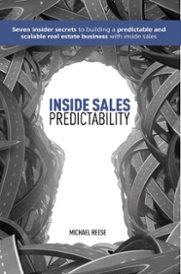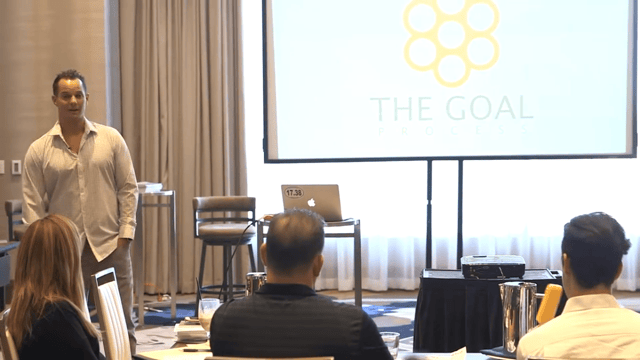“Everybody wants a gold medal, few people want to train like an Olympian.”
Most people, when asked the question: “Do you have a goal?” often respond with a quick “Yes”. In that moment, I’m always curious what they would have said if you asked “Can you share your plan to hit your listings sold goals and the metrics to show if your on pace?”.
You see, I’m completely obsessed with “The Process” for hitting my goals.
It was December and I was reviewing the metrics to figure out why we weren't going to hit our goals. I kept asking myself: “Where are we off on our assumptions as to where the bottleneck exists...what was the constraint?”.
I had come to the conclusion earlier that month the bottleneck was the productivity of my inside sales department. However, I didn’t take that as gospel because of a mental model I learned that has always served me well: “I always assume I’m wrong and want to be less wrong”.
This mental model is a simple framework for thinking as it keeps your ego out of the equation. Some of the hardest problems I've ever had to solve were because of solutions I’ve found where I started by thinking I was wrong. I honestly think my best advantage is outlearning my competition so I always want to be in learner mode and not assume I’m right in what I’m thinking.
In this scenario, I followed my process and as I evaluated all of the data, metrics, and assumptions, I came to realize that I had a lead generation problem.
The truth is, I've learned how to set and reach goals and I believe it's become my number one success habit. Every year, I've learned from a detailed, hyper-real, self-reflective process of where I am not succeeding with the goal of really trying to get to the root of where I fell short. What I’ve learned about myself is that when I deconstruct all of the steps to accomplish the goal. By chunking it down to a single metric or two that I monitor daily, I always hit it. More importantly I instantly know when I’m not living in a way that is congruent with my goals.
The bottom line in goal setting for me is this: if the desired outcome was extremely important to me, I would invest the time to reverse-engineer all of the steps that were required to accomplish the goal.
You see, success is rarely because of the process of defining, documenting, and communicating the why or what in regards to my goals. My success has always come from the “sacrifices and the price that I was willing to pay” and being clear around that process: “How was I to accomplish the goal where was I uncomfortable?” Then, and only then, did I make the decision that I was or was not willing to “pay the price”.
If you have a goal to grow your business by listing more homes, then I’m going to show you the “TRUTH” behind why some will and other’s won’t hit their goals this year or next.
Let’s break this down into a few easy-to-follow steps.
Step One: Define the Goal
So let's start with defining the goal. The first few questions you need to ask are: “What is the goal?”, “Is that really the goal?” and “What are all the ways to accomplish the goal?”.
Another mental model of mine is that you’d rather measure twice and cut once. Said differently, you don't want to work on the wrong thing in the right way. When I'm going after listings, I want to know what’s price point and what’s location. All listings aren't the same, so I'm going to be more specific in relation to the type of listings I’m going after. So be very specific: is your goal to get more listings or is it to find a strategy to consistently deliver 5 new listings in a specific a specific neighborhood or price point.
The difference between getting more listings and finding 5 new listings, listing 20 new homes or getting market share in a very target neighborhood is that the latter goals give me way more clarity on actionable items.
When I have a listing goal, I'm going to know the type of listing I want to list and how many of them I want to list. For example, if I want to list 10 homes, I would know what percentage of those were going to come from which lead sources. I would also know what percentage of those listings were going to be from inbound calls vs. outbound calls.
Additionally, I would know what the required investment of my money or time was going to be required for me to generate those appointments. Lastly, I'm going to be specific as to how much revenue those listings are going to yield.
In the end, I might not choose a number of homes sold, but rather I might have a commission goal in relations to those listings. In the end, the main point is you want to make sure your goal is very specific in nature.
Step Two: Establish Conversion Assumptions
If your goal is to get listings, then you have to know where those listings going to come from. To get clear on the sources, you should ask yourself these questions:
- Are they going to come from prospecting calls?
- If so, what percentage are going to come from expireds vs. for sale by owners?
- Are they going to come from Circle prospecting?
- Are they going to come from new expireds are old expireds or both?
- Are they going to come from past clients are referrals?
I want to have conversion assumptions that are usually going to be dynamic based upon my lead source. For example, if I was going to use an Inside Sales Associate to make outbound calls to cold prospects the conversion cycle of the prospect from speaking to me to listing their home is shorter.
However, if I run an ad on Facebook, the prospect could be looking at a picture of Eminem’s 21-year-old daughter or an anaconda eating cow before looking at an advertisement of mine. It’s likely that they did not log onto their Facebook page saying to themselves: “Man, I need to get my home on the market, let me go see if anyone on facebook can help me today.”
The conversion cycle on those types of leads might take an average take 3 months to incubate. And, if you don't have a system to nurture those opportunities, you could be "wasting" a lot of money.
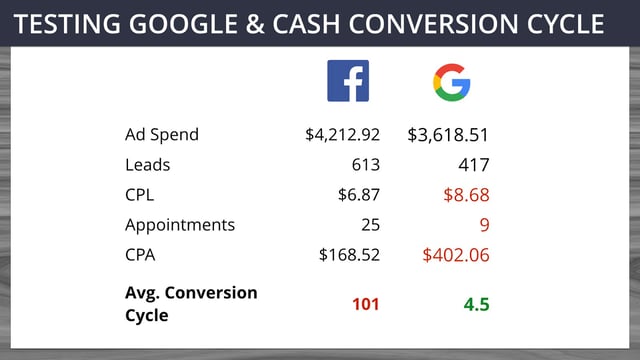
In fact what we have found is there is even a difference based upon the leads traffic source. You can run traffic on Facebook vs. Google to the same funnel and they will have a different cost per appointment.
They will also have a different conversion cycle, which is based on the time the lead is generated and the time it’s willing to set a face-to-face appointment.
Your goal is to know what your assumptions are based on the fact that you're going to actually do something to hit your goal. Again, your plan to hit your goals needs to include how many of those appointments are coming from expireds, branded billboards, Facebook, referrals, etc. It’s crucial to know these metrics.
For example, let’s say your goal is to list 100 homes next year and you’ve broken it down in such a way that you know 10 of them are coming from referrals. The next question you should ask is: “What are you going to do in order to generate those referrals?”. You can’t say they're just going to happen; not if you really want to hit your goal. To hit your goal, you will need a referral system that yields X% of referrals. A system that is managed, monitored, and responsible for producing those referral. And, f your system stops working, you need to find another strategy to get back on pace.
The Power of Outbound Models
I love outbound models, they give a lift to everything. Great outbound models allow you to go in like a surgeon and impact the entire plan at will. I’ve been able to produce the results I want with an outbound model because I know the math literally down to the investment for the labor to produce that result. Anytime I was ever off, I increased the amount of outbound calls required to hit my numbers.
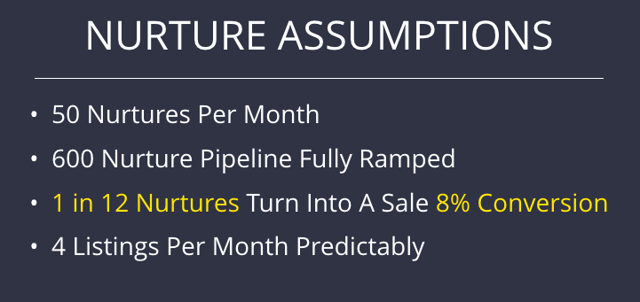
If you don’t have an outbound strategy, it’s simply because you’ve not take the time to do the math.
In our business, if we wanted four listings a month from our circle prospecting, then we knew to the exact number of how many nurtures we needed to have going into that month. We even built our model up against the seasonality curve to ensure we could hit our goal.
So, please don't just say I'm going to focus on listing, break it down to the how. Lay out the assumptions of what you think it's going to take on a daily basis based upon the amount of time your going to need to invest.
I honestly believe the number one person in every market can trace back there growth. To a handful of simple decisions. Decisions that at the time seemed hard, scary, and made them uncomfortable. Get use to being uncomfortable.
If you want to become great, if you want to dominate your market, you're going to have to make some decisions. So let’s decide on a goal, then let’s layout the assumptions that we believe it’s going to take to hit that goal.
For growing listing business, one of my favorite assumptions to make is based on what percentage of the leads you generate are you going to make contact with.
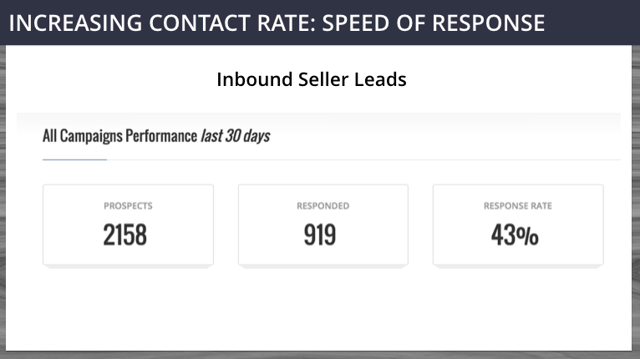
Here’s an example. Let’s say you have a 29% spoke to ratio, that means you speak to 29% of all your leads. The reason for this could be related to the fact that you call them back 3 times. Or maybe it’s because sometimes, you call them back the same day and that might depend on what time of the day. Or, maybe every other weekend you have your kids so you only call back once and it’s usually late at night on those weekends. No matter what the reason, it’s not consistent and predictable.
At a 29% spoke-to ratio, you would need 300 leads to generate 87 conversations.
Now, if I have a touch plan that sends text messages, phone voicemails, and emails seven days a week, resulting in 43% of all my leads reaching out to me, consistently and without fail, then I just need 200 leads to generate the same amount of conversations you do.
So, assuming your cost is $8 per lead, instead of spending $800 on 100 more leads to get the same result, you just need to increase your contact ratio by investing in a systemized process like a touch plan automation.
Another great one to track is you want to know your cost per contact? This will help you balance your marketing and sale’s efforts.
If you want to see a great example of how to do the math to know if something is worth your time, look up the Baylor University Cold Call Research Study. This was a study that was done through a partnership between Baylor and Keller Williams. After reading it, you should be clear on where it’s best to invest your time.
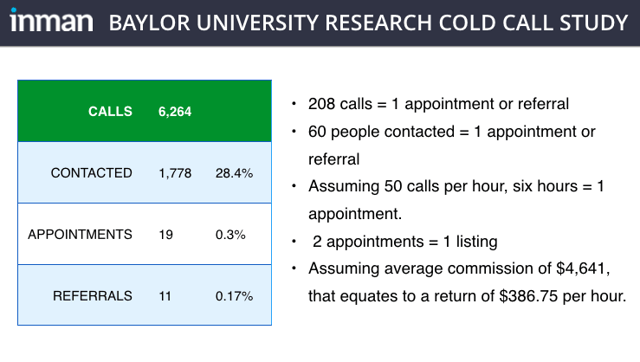
Step Three: Audit for Resource Constraints (Action and Resource alignment)
Where most of us fall short when setting a goal is in deconstructing the goal down to the KPI’s that are in our control. To accomplish our goal, we need to know the actual activities in our control that allow us to influence the outcome we are hoping to accomplish. In order to identify these KPIs, these are some of the questions you can ask:
- What percent of your leads are going to come from inbound versus outbound?
- Do you have enough leads?
- Did your spoke to ratio assume a speed of response in under 5 minutes?
- What percentage of your leads come in on Sunday?
- Do leads over the weekend get followed up on?
- Based upon the amount of calls required to convert a lead, are you making those calls?
In short, make sure that all your stuff adds up. Do everything you can to have a goal that is verified from the results of your process and not just something you’ve pulled out of the clear blue sky. That way, when the results are not being achieved as you had hoped, you can isolate where to spend your time.
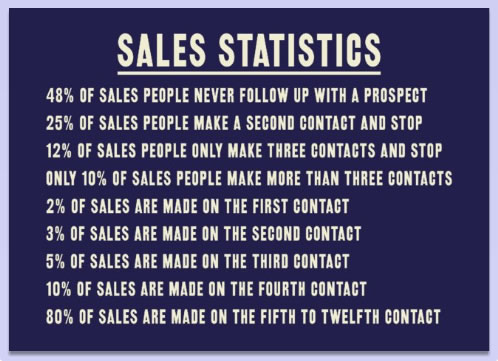
Step Four: Calculate the Gap
You know exactly how many leads you're going to need and you know exactly how many dials you're going to need to reach your goal. However, you don't have the money to generate the leads or the time to consistently invest into prospecting to generate the appointments.
This is where I see many people fail because they don’t take the time to do the math.
Every lead you generate, every lead you convert and every appointment you set has a cost associated with it. You should do the math on the allowable cost that you're willing to both invest in time and money to acquire those appointments. And in the event you're too busy to invest your own time, you should be willing to invest in a hire that will trade their time for your money to help you get the predictability and results you need.
The question is how much money or time do you need to invest above and beyond what you were currently planning or are willing to invest?
Here’s a real-life scenario from my real estate business.
The expireds and FSBO’s in my market that didn't list with me were always a loss of revenue for my business as far as I was concerned. As my business started taking off, I stopped doing the basics, including prospecting the low-hanging fruit. As well, I also love going to the lake on the weekends, so calling consistently became a challenge for me.
The thing is, I put 4 deals under contract my first 30 days in real estate and they all came from expireds and FSBO’s. So, for me not to call expireds and FSBO’s was unacceptable. In my mind, the math was real simple: pay somebody else to make the calls. All I had to do was generate enough transactions that allowed me to pay them and the money I earned that was above and beyond my investment in them was profit.
From my standpoint, doing this was a no brainer. I had a background in training salespeople and my belief was skills could be learned. So, that meant if I had the right person doing the right things and doing them well based on how I trained them, I could be on going on more appointments and doing less of the things I did not enjoy, which in for me was sitting on the phone stuck in the office.
In the end, make sure you find the gap between your plan and your current resource capacity. Then, remember just because it calls need to be made does not mean you have to be the one making the calls.
Step Five: Plan for Closing the Gap
Create a plan to close the gap. One of my biggest mind shifts happened in 2014. After generating over 150,000 leads online nationwide - specifically homeowners looking to sell their property - I learned that 9% of those people actually did list and sell their home.
Surprisingly, none of the other 91% moved at all.
Using this data as target, I started doing some lead generation in my own back yard for one of our agents. Unfortunately, the market was super competitive with so many advertisers. I couldn’t get anywhere close to the $8 price I paid on a national level. I ended up paying more than three times that: $28.
The number of leads I was getting and the cost I was paying for them was prohibitive. I just couldn’t sustain it.
So, I did what I always do. I asked myself: “What’s the goal?” and “Is that really the goal?”
Then, I did the math on how to close the gap and decided that I would invest in labor and data to accomplish my goal. First, I found neighborhoods that had greater than a 9% conversion. Then, I employed an ISA and had them engage in leveraged lead generation, otherwise known as circle prospecting in those neighborhoods.
That to me was a GAME CHANGER.
The difference between running an ad then waiting 30 days to generate 39 leads was gone. I could go into a market with predictive data models and get phone numbers for thousands of homeowners that we're going to be selling in the next 1 to 18 months, all for pennies on the dollar.
With that model. I decided to invest in the labor dollar to have someone call them and do a home ownership survey.
Brilliant!
Now covering the gap in my goal became easy. In the areas where I wasn't generating enough opportunities, I could focus outbound sales development reps on helping identify qualified opportunities.
These were also opportunities nobody else was usually pursuing. I was now getting to the homeowner in advance of the selling process, which resulted in large pipelines of specifically-targeted homeowners wanting to move.
Changing our approach to doing this started making everything way more predictable.
In fact, while the Internet and inbound leads were great, my automated touch plans that leveraged slydial, text, and e-mail got me a better connect rate than calling the lead 8 times.
Again, make sure with you have a plan to close your gap to achieve your goal.
Step Six: Establish 2 critical Economic KPI’s to Monitor the Gap
At this point, it should be clear that If you want to hit a goal, you must establish your critical numbers. If there’s a gap between where you are and where you want to be, you need to determine two critical revenue driver metrics for yourself.
In order to decide what they should be, ask yourself the following question: “What are the two revenue drivers that would allow you to say ‘I will hit my goal if I do “these” two things every day?’”
For me, it’s two outbound and inbound metrics. I specifically look at:
- Outbound Metric: How many people are you going to have to make contact with in order to get an appointment?
- Inbound Metric: What percentage of my leads will I make contact with in the first 72 hours?
If you can this distill your plan down to two metrics that you can see everyday in real time and know for the day, the week, and the month of the year whether you're off pace or on pace can give you instant clarity and focus in relation to the decisions you need to make as you work towards accomplishing your goal
Step Seven: Verify Assumptions vs. Actuals
Every month, you must evaluate your assumptions vs. your actuals. If you assume you can generate 161 leads for $7, when in fact it's $28 per lead, then you probably won't hit your goal.
You must absolutely verify your assumptions by looking at what you actually got for results.
For instance, there are a lot of factors that can influence your cost per leads. Things like ad fatigue and new angles you take in your messaging can impact your assumptions and affect how much you pay for each lead. So, you need to take these factors into consideration when looking at your results.
In addition to monitoring your cost per lead, you should also be looking at your ROI per lead which, in my book, is more important. Some of the best ROI I've seen had high a cost per lead.
I hear so many people set goals specific really around a cost per lead metric, when they should set them around the cost to acquire a customer.
The last thing you want to do is make your assumptions and get 1,000 leads for $4 each in order to generate a transaction when there was alternative solutions that got you 5 leads at $60 leads to generate a transaction.
You must know what you’re missing and then ask yourself: “How am I going to make up what I’m missing”.
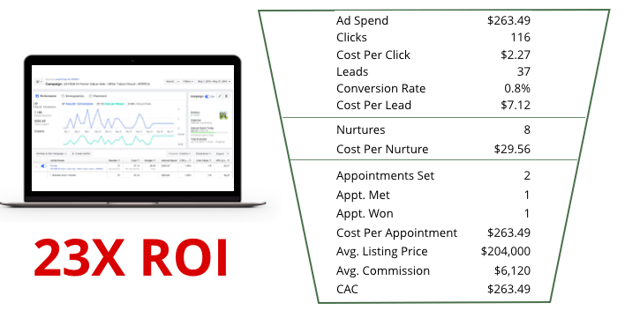
Step Eight: Define the Constraints to Goal
There is a book called The Goal that you should read. It’s based upon the theory of constraint. It’s a must read and it really will help you in solving problems with your sales and marketing funnels.
Ultimately it’s your job is to identify a what is the number one thing keeping you from getting to the goal. Once you've identified that specific thing, you have to solve that problem.
If you take the best-trained person on the phone in your office and give that person consistent leads, the result will be consistent listings.
You either have a lead generation problem or a lead conversion problem.
Most people conclude that if they are not dominating the listing market it's due to skills or effort.
The good news is that's an easy problem to fix.
You either commit to getting yourself trained or hire somebody and get them trained. Or it comes down to an amount of time you're going to invest in making the calls. If that’s the case, you suck it up and do it or you hire somebody else to make the calls.
Doing nothing costs you the most money.
Now if it's not skills or effort, then it's your tools or lead sources.
My argument here is that you can get leads for $0.10 that have a higher probability converting then leads other people pay $8 to $30 each for.
Knowing this, nobody should have a lead problem.
I’ve spent a lot of time with some of the top agents in the country. I walked side-by-side with them on the path of the same journey I made. I learned I could never make someone a winner; however, I did find out that I can make a winner win bigger and faster. And the only way I was able to do that was by simply helping them think differently.
My favorite quote from Jim Rohn: “If you don't have everything you want, you simply haven't learned something yet. My questions for you are”What is the goal?” and “What's the price you're willing to pay (and what do you need to learn) to make that goal a reality?”.
Watch - The GoalPresentation ( Michael Reese )



